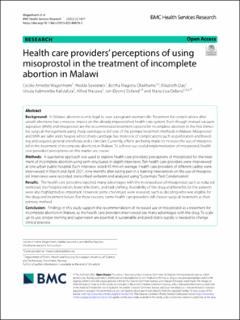| dc.contributor.author | Wagenheim, Cecilie Annette | |
| dc.contributor.author | Savosnick, Hedda Haraldsson | |
| dc.contributor.author | Chakhame, Bertha Immaculate | |
| dc.contributor.author | Darj, Elisabeth | |
| dc.contributor.author | Kafulafula, Ursula Kalimembe | |
| dc.contributor.author | Maluwa, Alfred | |
| dc.contributor.author | Odland, Jon Øyvind | |
| dc.contributor.author | Odland, Maria Lisa | |
| dc.date.accessioned | 2023-01-19T12:51:23Z | |
| dc.date.available | 2023-01-19T12:51:23Z | |
| dc.date.created | 2022-12-16T11:15:21Z | |
| dc.date.issued | 2022 | |
| dc.identifier.citation | BMC Health Services Research. 2022, 22 (1), . | en_US |
| dc.identifier.issn | 1472-6963 | |
| dc.identifier.uri | https://hdl.handle.net/11250/3044625 | |
| dc.description.abstract | Background
In Malawi, abortion is only legal to save a pregnant woman’s life. Treatment for complications after unsafe abortions has a massive impact on the already impoverished health care system. Even though manual vacuum aspiration (MVA) and misoprostol are the recommended treatment options for incomplete abortion in the first trimester, surgical management using sharp curettage is still one of the primary treatment methods in Malawi. Misoprostol and MVA are safer and cheaper, whilst sharp curettage has more risk of complications such as perforation and bleeding and requires general anesthesia and a clinician. Currently, efforts are being made to increase the use of misoprostol in the treatment of incomplete abortions in Malawi. To achieve successful implementation of misoprostol, health care providers’ perceptions on this matter are crucial.
Methods
A qualitative approach was used to explore health care providers’ perceptions of misoprostol for the treatment of incomplete abortion using semi-structured in-depth interviews. Ten health care providers were interviewed at one urban public hospital. Each interview lasted 45 min on average. Health care providers of different cadres were interviewed in March and April 2021, nine months after taking part in a training intervention on the use of misoprostol. Interviews were recorded, transcribed verbatim and analyzed using ‘Systematic Text Condensation’.
Results
The health care providers reported many advantages with the increased use of misoprostol, such as reduced workload, less hospitalization, fewer infections, and task-shifting. Availability of the drug and benefits for the patients were also highlighted as important. However, some challenges were revealed, such as deciding who was eligible for the drug and treatment failure. For these reasons, some health care providers still choose surgical treatment as their primary method.
Conclusion
Findings in this study support the recommendation of increased use of misoprostol as a treatment for incomplete abortion in Malawi, as the health care providers interviewed see many advantages with the drug. To scale up its use, proper training and supervision are essential. A sustainable and predictable supply is needed to change clinical practice. | en_US |
| dc.language.iso | eng | en_US |
| dc.publisher | BMC | en_US |
| dc.rights | Navngivelse 4.0 Internasjonal | * |
| dc.rights.uri | http://creativecommons.org/licenses/by/4.0/deed.no | * |
| dc.title | Health care providers’ perceptions of using misoprostol in the treatment of incomplete abortion in Malawi | en_US |
| dc.title.alternative | Health care providers’ perceptions of using misoprostol in the treatment of incomplete abortion in Malawi | en_US |
| dc.type | Peer reviewed | en_US |
| dc.type | Journal article | en_US |
| dc.description.version | publishedVersion | en_US |
| dc.source.pagenumber | 0 | en_US |
| dc.source.volume | 22 | en_US |
| dc.source.journal | BMC Health Services Research | en_US |
| dc.source.issue | 1 | en_US |
| dc.identifier.doi | 10.1186/s12913-022-08878-3 | |
| dc.identifier.cristin | 2094265 | |
| cristin.ispublished | true | |
| cristin.fulltext | original | |
| cristin.qualitycode | 2 | |

